Overview
Before the founding of the National Aeronautics and Space Administration (NASA) in 1958, Nazi Germany dominated the field of rocket science. Germany’s V-2 supersonic ballistic missile was intended to strike military troops and civilians in order to shatter morale in British cities and Belgian ports during World War II. To combat this threat, the Army Ordnance Corps began researching jet propulsion through a formal partnership with the California Institute of Technology (CalTech). Upon Allied victory over Europe and the American Cold War policy of containment, American military officers began the formal recruitment and relocation of former Nazi engineers to Army rocket testing facilities through Operation Paperclip in 1945. The National Security Act of 1947 expanded and redistributed the responsibilities of Army space research. The Army contributed to the space race and the creation of NASA through the Redstone Project, designing the first rocket to launch an American satellite into space, and engineering the first solar cells that increased the longevity of satellite life in space. Since the 1960s, the Army has demonstrated its ability to defend against and intercept air attacks through modern rocket and satellite research.
American Rocketry Beginnings
Dr. Robert H. Goddard pioneered America’s first rocketry program. Goddard invented the first liquid fuel rocket powered by liquid oxygen (lox) and on March 16, 1926, he tested the first American rocket to run solely on liquid fuel. Previously, rockets had only been tested with solid fuels which did not create as much thrust per unit of fuel as liquid fuel. In addition to his liquid fuel breakthrough, Goddard determined the vacuum conditions necessary for rockets to reach peak efficiency and designed a specialized combustion chamber and nozzle. The combustion chamber burned liquid fuel to create a gas exhaust, propelling backward and in turn thrusting the rocket forward. Through the 1930s, American rocket scientists continued researching this concept of propulsion. Germany’s invasion of Poland in 1939 accelerated the Army’s interest in rockets. Theodore von Kármán and Frank J. Malina of CalTech’s Guggenheim Aeronautical Laboratory (now the Graduate Aerospace Laboratories) subsequently had their jet propulsion research approved and funded by the Army. A formal working relationship between the U.S. Army Air Corps and CalTech took shape. By 1942, von Kármán and Malina had successfully tested jet propulsion with solid and liquid fuel propellants. The Allies were aware of potential Nazi missile performance before Germany tested the V-2 rocket in 1942. As a result, the U.S. Army Ordnance Corps worked quickly to develop storable fuel and more efficient jet engines for the Army Air Corps to use against new threats.
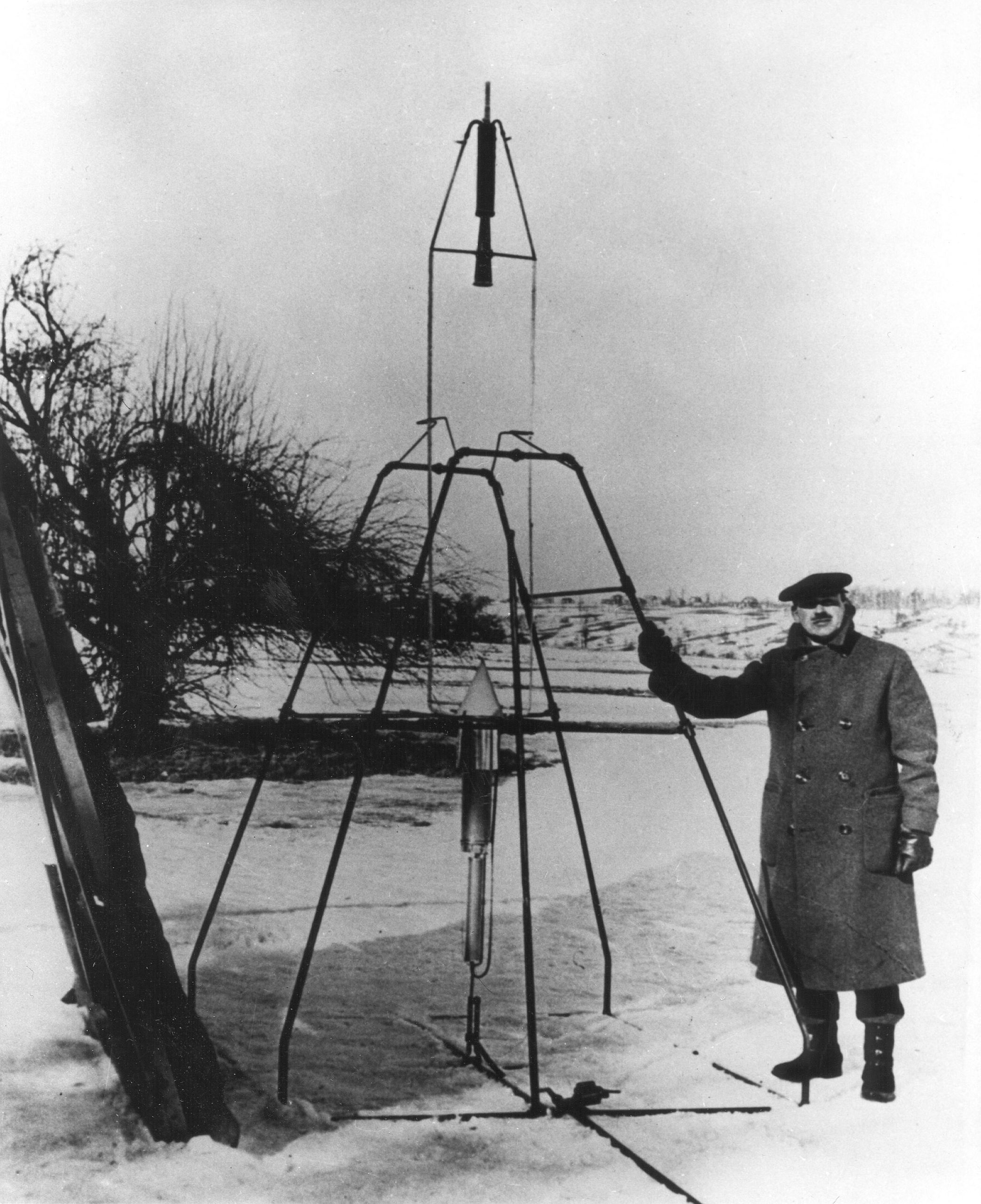
Dr. Robert Goddard with his rocket. National Aeronautics and Space Administration
The V-2 and World War II
German physicist Hermann Oberth, considered to be one of the founding fathers of rocket science, discovered the amount of thrust needed to launch objects into orbit and the necessary mathematical proportions and calculations for rocket design and flight. This culminated in his 1923 publication, “The Rocket into Planetary Space.” Oberth’s work inspired the founding of the German Society for Space Travel in 1927, under which a new and prominent scientist named Wernher von Braun began researching the capabilities of rockets as a weapon of war. In the early 1930s von Braun received increased funding from the German Wehrmacht for his work. By Adolf Hitler’s rise to power in 1933, von Braun had attained high status in the Society for Space Travel. Von Braun worked closely with German General Walter Dornberger, and in 1937 they moved their research to Peenemünde, a rocket testing facility in eastern Germany on the Baltic Sea. After von Braun was formally recruited into the Schutzstaffel (SS) as a lieutenant in 1940, Dornberger and von Braun’s team got to work in Peenemünde. To the Nazis, rockets represented retaliation against allied bombing campaigns. Thus, after the first successful launch of the V-2 rocket on October 3, 1942, Hitler ordered mass underground production of the V-2. The heavily propagandized V-2 was nicknamed the “vengeance weapon” but proved to be remarkably ineffective. V-2 rockets during World War II only hit the intended target approximately one third of the time and allied morale remained intact. Yet, the British National Archives estimate approximately 43,000 people died or were misplaced because of the bombings. Plus, thousands of laborers from the Mittelbau concentration camp ordered to blast tunnels to the subterranean fabrication plant at Pennemünde died during production and testing.
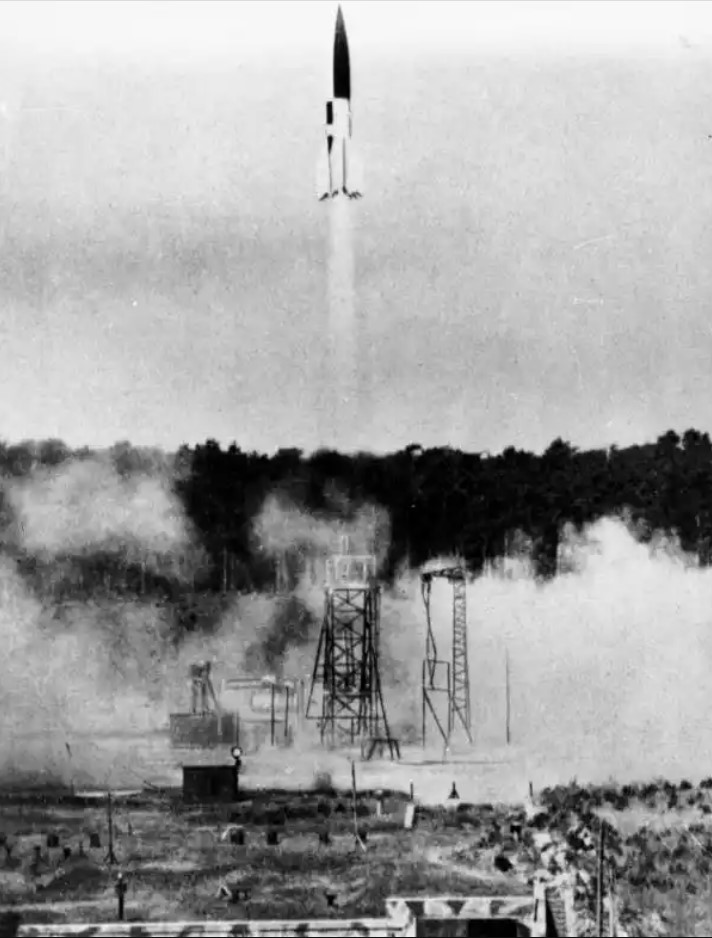
V-2 rocket launch, Summer 1943. National Aeronautics and Space Administration
The U.S. Army made important strides in communications innovations by 1945 to surveil the German rocketry program and gather Soviet intelligence. Aerial reconnaissance photography helped the Army spy on enemies during World War II and into the Cold War. Moreover, Army codebreaking helped to decipher enemy plans during the war. The Army Signal Corps maintained a sophisticated and secure global communications system. In 1946, the Signal Corps transmitted radar waves to the Moon for the first time in Project Diana.
Despite these accomplishments, the U.S. Army still struggled to comprehend the engineering, production, and effects of the V-2 during World War II. However, the Army’s early interest in rocketry helped create a center for liquid fuel and jet assisted take off research and testing in Pasadena, California. Army Ordnance requested von Kármán to research Allied intelligence gathered on the V-2 to better understand the supersonic ballistic missile. Von Kármán’s team at CalTech formally referred to themselves as the “Jet Propulsion Laboratory” (JPL) for the first time in an Army contract. Meanwhile, the Army countered V-2 attacks with more air raids and strikes targeting Nazi fuel facilities and production centers. This was a successful strategy in Europe and led, in part, to the German surrender on May 7, 1945. The Army’s support of JPL fostered future innovation in air navigation, fuel efficiency, and flight control, but the most important developments in space travel happened due to new partnerships forged during the Cold War.
Vengeance Weapons
The V-2 was not precise. Nonetheless, U.S. military planners after World War II saw potential. Following the war, Col. Gervais Tichel, chief of the Rocket Development Branch within Army Ordnance, ordered more than 100 V-2s to be shipped to the United States along with tons of paperwork, trainloads of missile parts and hardware, and hundreds of personnel. The transfer of German personnel by U.S. intelligence would come to be known as “Operation Paperclip.” This process began when Tichel’s subordinates, Col. Holger Toftoy and Maj. James Hamill first contacted and transported former Nazi rocket scientists to the American occupation zone before clear occupation lines had been drawn in the spring of 1945. The Army Ordnance Research and Development sub-office relocated hundreds of personnel from the American occupation zone to Fort Bliss, Texas.
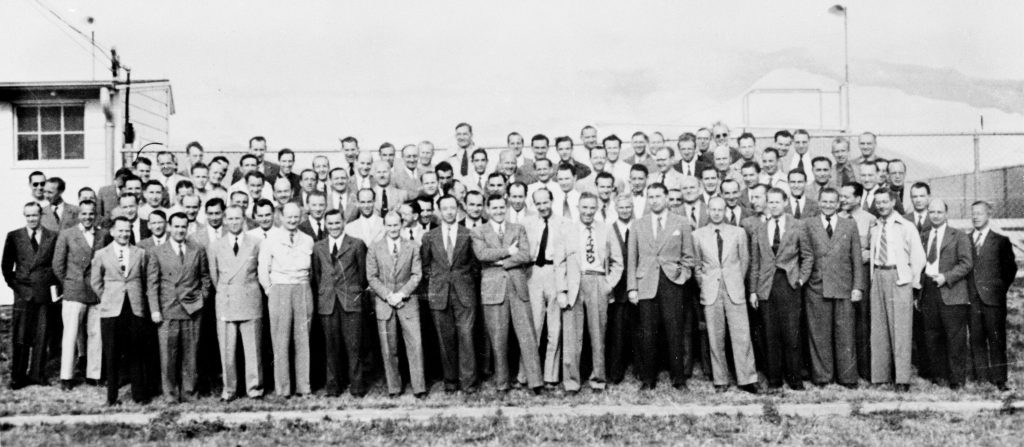
The Paperclip Crew including von Braun. National Aeronautics and Space Administration
One man was critically important for the U.S. to recruit: Wernher von Braun. Von Braun and his colleagues were offered six-month contracts if they agreed to work with the U.S. Army. Many of the recruited scientists began rocket research linked to Army interests in long range artillery. The Army chose White Sands Proving Ground (WSPG) in New Mexico as a rocket testing center in 1945. The Army moved American civilian engineers in the 1st Ordnance Guided Missile Support Battalion and many German scientists to WSPG. White Sands became the center of V-2 maintenance and test launches and the site of the first atomic bomb test, the “Trinity Test,” on July 16, 1945.
Because of growing rocket innovation, the Army Ordnance Department in 1948 selected the Redstone Arsenal in Huntsville, Alabama, as a rocket research center. The secretary of the Army approved the transfer of rocket research there along with 800 military personnel including German scientists and engineers, Army engineers, and contract employees. In addition, the Navy established a testing site at Cape Canaveral, Florida, to test longer range missiles and rockets in 1949. The Army distributed several V-2’s to the Navy and Air Force to modify and test in new rocket testing centers.
The stakes of Operation Paperclip were high. Among the captured documents and rocket parts, Army Ordnance investigations found that during the war, the Germans had begun researching rocket propulsion and multistage long-range missiles. Plans for intercontinental ballistic missiles (ICBM’s) capable of a 3,500-mile range were found among captured documents. Discovery of these plans catalyzed Operation Paperclip and intensified the Cold War. In the east, the Soviets lagged behind. They failed to fully analyzing previous rocketry discoveries made by early 20th century rocket engineer Konstantin Tsiolkovsky until 1945, when they sought to prove the technological superiority of communism. As a result, the Soviet Union’s Prime Minister Joseph Stalin established the Soviet Jet Armament Rocket Program in 1946. The Soviets were slow to recruit German rocket personnel but did have a smaller recruitment program led by former Nazi, Helmut Grottup. The Soviets unsuccessfully attempted to kidnap von Braun twice. The key element they possessed was access to former German rocket testing facilities in their occupation zone, such as Peenemünde.
Before NASA
Awareness of the Soviet threat heightened American competition at home among the Armed Forces. The Army had been the chief sponsor of rocketry work completed from 1940-50, but Secretary of Defense James V. Forrestal reassigned tasks to each branch, including new satellite research responsibilities, upon the passage of the National Security Act of 1947. The act created a newly independent air force and established departments for each branch, rather than the previous War Department. The U.S. Air Force now headed most satellite research to suit their role in strategic air power, but the Army retained responsibility for space communications and missile research. The Air Force and Army clarified their priorities in August 1950, with the Vandenberg-Collins Agreement to create a joint effort in air defense. From 1950-53, Cold War tensions in Korea engulfed American national security interests. The Soviet Union and China signed a Sino-Soviet Alliance in 1950, amplifying the stakes of the North Korean invasion of South Korea. To meet national security demands, the Army, including von Braun’s team, conducted the first Redstone rocket tests on August 20, 1953. The rocket could strike a target within a 500-mile range. Because of this advancement, the Army was able to explore greater missile ranges after the armistice that ended the Korean War.
In 1955, the National Security Council (NSC) and scientific advisors recommended to President Dwight D. Eisenhower that ICBM research become a national defense priority. The expansion of ICBM research further defined the Army’s role in the Cold War. In 1956, Secretary of Defense Charles Wilson tasked the Army to develop land-based surface-to-air missiles in response to Soviet long range missile production. To specifically address the threat of Soviet aerial attack, the Army Ballistic Missile Agency (ABMA) in Huntsville and Bell Telephone Laboratories (now Nokia Bell Labs) began working on missile defense. This took shape in Bell Labs and the ABMA’s Project NIKE, which developed missiles to counter supersonic rockets. After successful tests in 1956, ABMA and Bell Labs demonstrated the novel ability to intercept a formation of enemy aircraft using the NIKE-HERCULES rocket.
The Soviet satellite launch of Sputnik in 1957 shocked the United States and redirected Eisenhower’s attention to satellites. Prior ICBM research proved useful in delivering satellites into orbit. On November 8, 1957, Eisenhower directed the Army to launch a satellite into orbit using a Juno rocket. This rocket was designed to endure longer periods of time in space. Redstone research provided the plans and information needed to launch a satellite within a few months of Sputnik. Finally, on January 31, 1958, JPL and ABMA launched Explorer I aboard an Army Juno I rocket. Explorer I orbited for roughly four months, one month longer than Sputnik. This success also meant that the Army, von Braun’s team at Redstone, and the ABMA had created and launched America’s first earth orbiting satellite and ballistic missile.
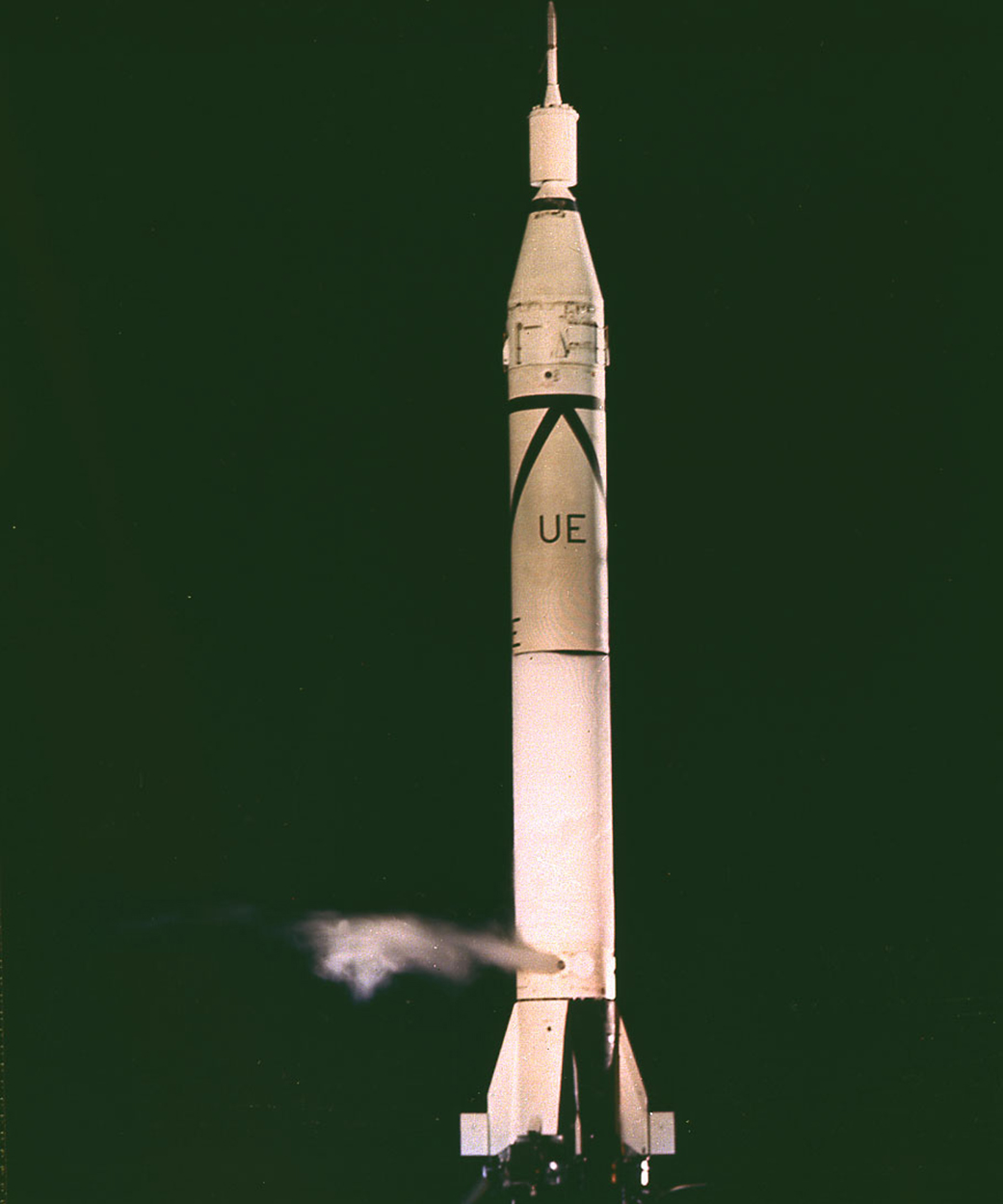
Explorer I on top of a Jupiter rocket. National Aeronautics and Space Administration
After the successful Explorer I launch, the Army Signal Corps and the U.S. Navy wanted to power satellites more efficiently so they could remain in orbit longer. Hans K. Ziegler, a former Wehrmacht chief of research and immigrant under Operation Paperclip, was working for the Signal Corps in Fort Monmouth, New Jersey, when he proposed an innovative solution: photovoltaic solar cells. Army Signal Corps mechanical engineer Andrew J. Herchakowski designed the cells and solar windows that were proposed. The cells processed energy from the sun to power radio transmissions and other instruments on board. Most of the photovoltaic cells were launched by the Navy in 1957 on the Aerobee rocket from WSPG, but some were incorporated into the Vanguard satellite, launched by the Navy from Cape Canaveral on March 17, 1958. The success of the solar cells in the Vanguard satellite enabled the military to advance missile defense systems, chart places of significance to the military, and expand communication. For example, solar powered satellites enabled the Army Map Service to chart islands in the Pacific that had been impossible to detect beforehand. Also, the Army could now control ICBMs and transmit radio signals between space and Earth.
Mounting inter-service space projects and the expansive civilian applications of satellites were complex. To redistribute the new responsibilities of outer space technology, Eisenhower created the National Aeronautics and Space Administration (NASA) on July 29, 1958. Consequently, NASA acquired employees, buildings, and equipment from the Red Stone Arsenal including von Braun’s team. Missile contracts between the Army and CalTech’s JPL were also inherited by NASA. Eisenhower defined the Army’s new role in space innovation to chiefly concern defense communication projects. Under this new role, the Army made several significant advancements. The Army launched the first communications satellite, produced and designed Jupiter and Juno rockets for NASA, and developed a missile-intercepting system during NIKE-ZEUS testing.
The Army Signal Research and Development laboratory, with help from the Air Force, launched the first communications satellite, called Project SCORE (Signal Communications by Orbiting Relay Equipment) in December 1958. SCORE channeled messages from one point on earth to any other location through a satellite. The Air Force’s Atlas rocket launched Project SCORE into space carrying a stored recording. The message, transmitted through a shortwave radio frequency, was from President Eisenhower wishing “peace on earth and goodwill toward men.” The breakthrough Project SCORE and successful Vanguard launches enabled the Army Signal Corps to develop a weather satellite in 1959. This research served as the basis for the 1960 NASA TIROS (Television Infrared Observation Satellite) that could transmit images of cloud patterns to bases in New Jersey and Hawaii. NASA used Army Jupiter and Juno missiles for various space missions between 1958 and 1960, including the Pioneer II and Pioneer IV which voyaged to the Moon and the Explorer VII satellite which took various measurements from space including earth’s radiation balance.
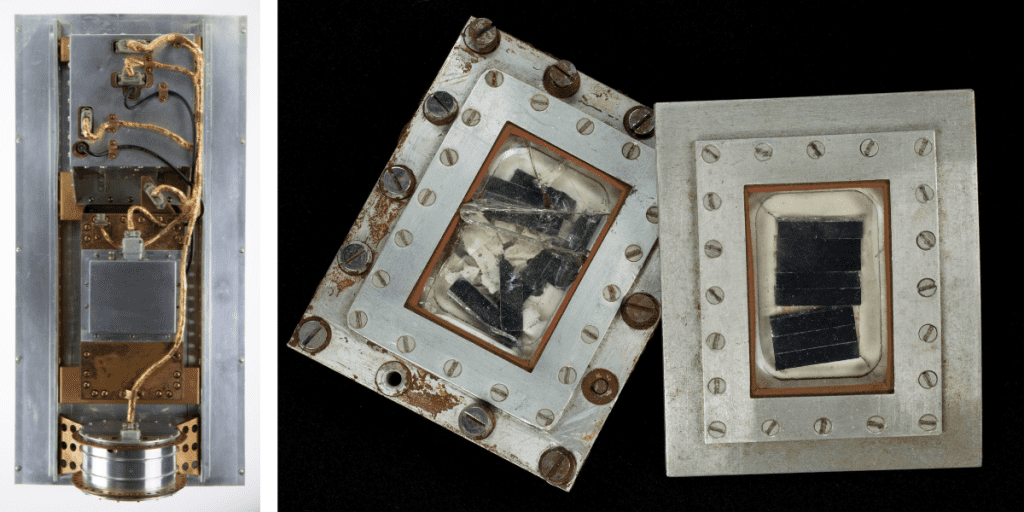
(left)Project SCORE and (right)the first Photovoltaic Solar Cells on display at the National Museum of the U.S. Army.
The Army Rocket Guided Missile Agency (ARGMA) furthered the Ballistic Missile Defense responsibilities of the Army. Because of the Soviet Union’s announced ICBM test flight in 1957, the NSC prioritized the antimissile missile development program in 1958. As a result, the Army acquired the Kwajalein Missile Range (now the Ronal Reagan Ballistic Missile Defense Test Site) in the Marshall Islands from the Navy to conduct antimissile tests using NIKE-ZEUS missiles. After several test launches in 1960 at the recently renamed White Sands Missile Range, NIKE-ZEUS antimissile capabilities were ready to be tested at Kwajalein. On December 14, 1961, the NIKE-ZEUS intercepted a NIKE-HERCULES missile successfully, proving the Army was capable of defending against any possible nuclear attack from a surface-to-air missile.
Clare Williams
Museum Education Intern
Sources
Bille, Matthew A., and Erika R. Lischock. The First Space Race: Launching the World’s First Satellites. College Station: Texas A&M University Press, 2004.
Downey, Arthur J. The Emerging Role of the U.S. Army in Space. Washington, DC: National Defense University Press, 1985. https://apps.dtic.mil/sti/citations/ADA187370.
Von Braun, Wernher. “Audio Recording of Wernher von Braun.” United States Holocaust Memorial Museum. Last modified July 28, 2022. https://collections.ushmm.org/search/catalog/irn48075.
Walker, James A, Lewis Bernstein, and Sharon Lang. Seize the High Ground: The U.S. Army in Space and Missile Defense. Washington, D.C.: U.S. Army Space and Missile Defence Command, 2003.
Additional Resources
“British Response to V1 and V2.” The National Archives. Accessed October 4, 2022. https://www.nationalarchives.gov.uk/education/resources/british-response-v1-and-v2/.
Court, Darren, and Jenn Jett. “Von Braun, the V-2, and Slave Labor.” White Sands Missile Range Museum. July 27, 2020. https://wsmrmuseum.com/2020/07/27/von-braun-the-v-2-and-slave-labor/.
“Hans K. Ziegler [Biography].” IRE Transactions on Military Electronics, MIL-4, no. 2-3 (1960): 62. Accessed October 4, 2022. https://ieeexplore.ieee.org/stamp/stamp.jsp?arnumber=5008201.
Neufeld, Michael J., “Mittelbau Main Camp: In Depth.” Holocaust Encyclopedia. Accessed October 4, 2022. https://encyclopedia.ushmm.org/content/en/article/mittelbau-main-camp-in-depth.
“Redstone Arsenal Historical Information.” U.S. Army Aviation and Missile Life Cycle Management Command. Last modified August 6, 2021. https://history.redstone.army.mil/index.html.
